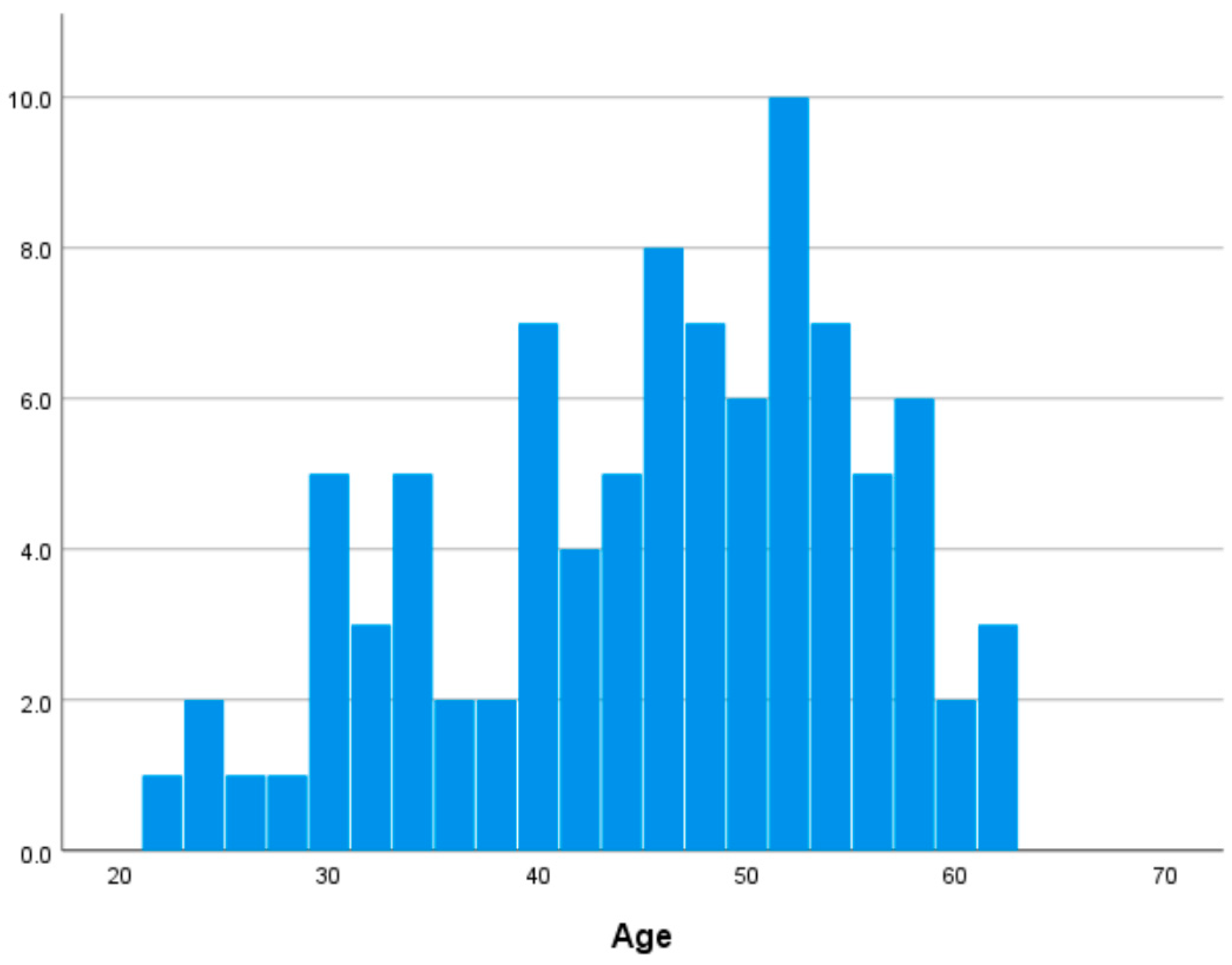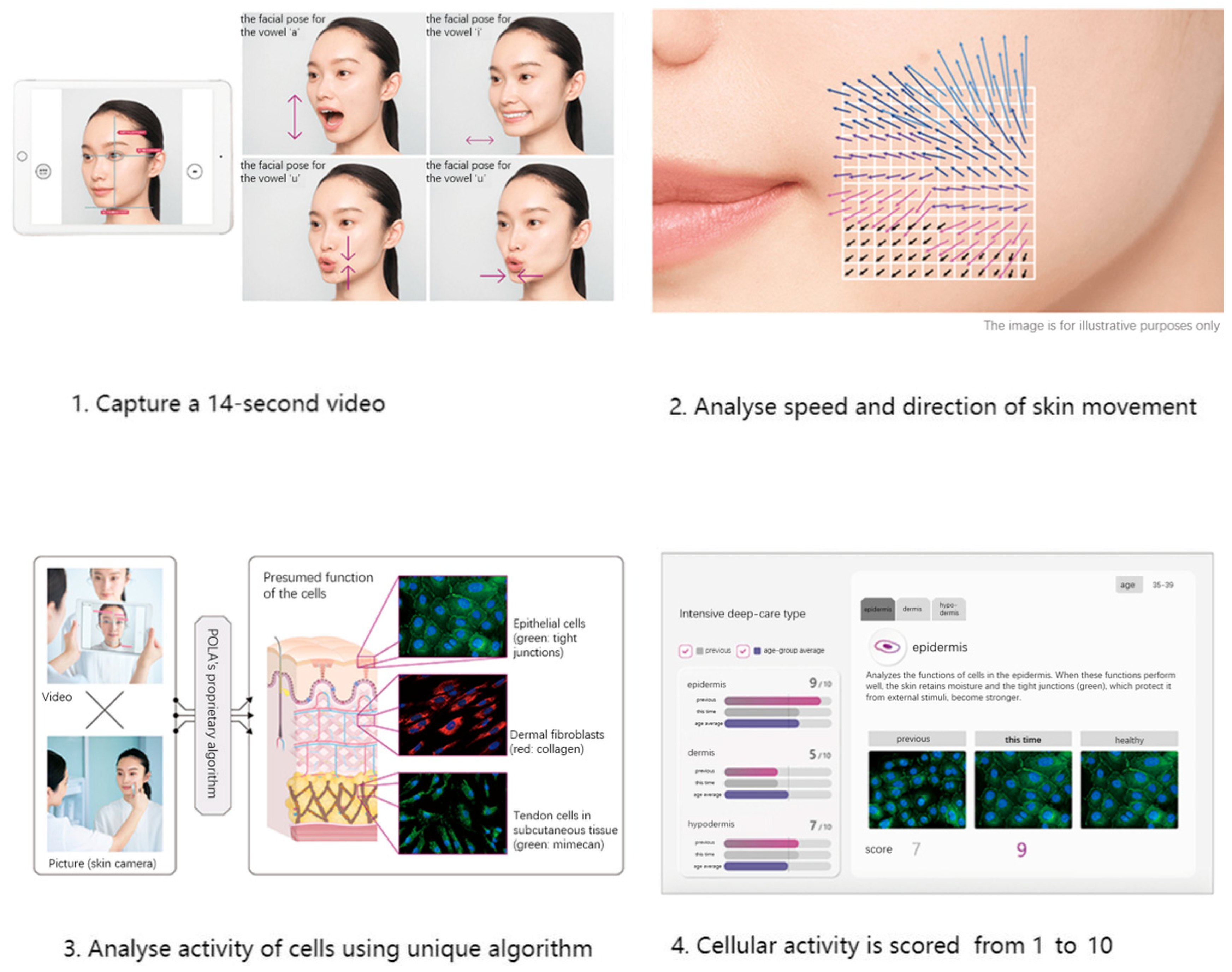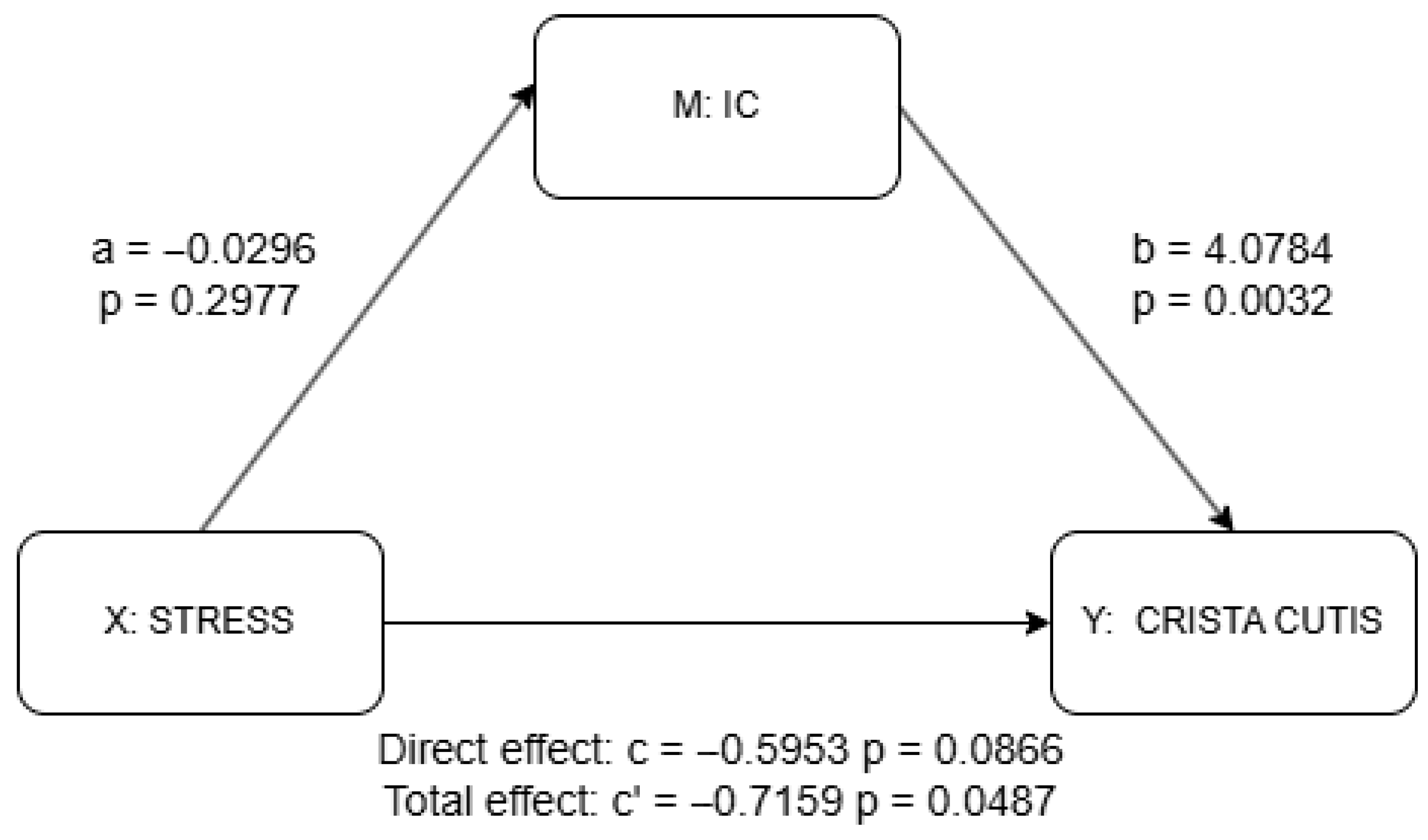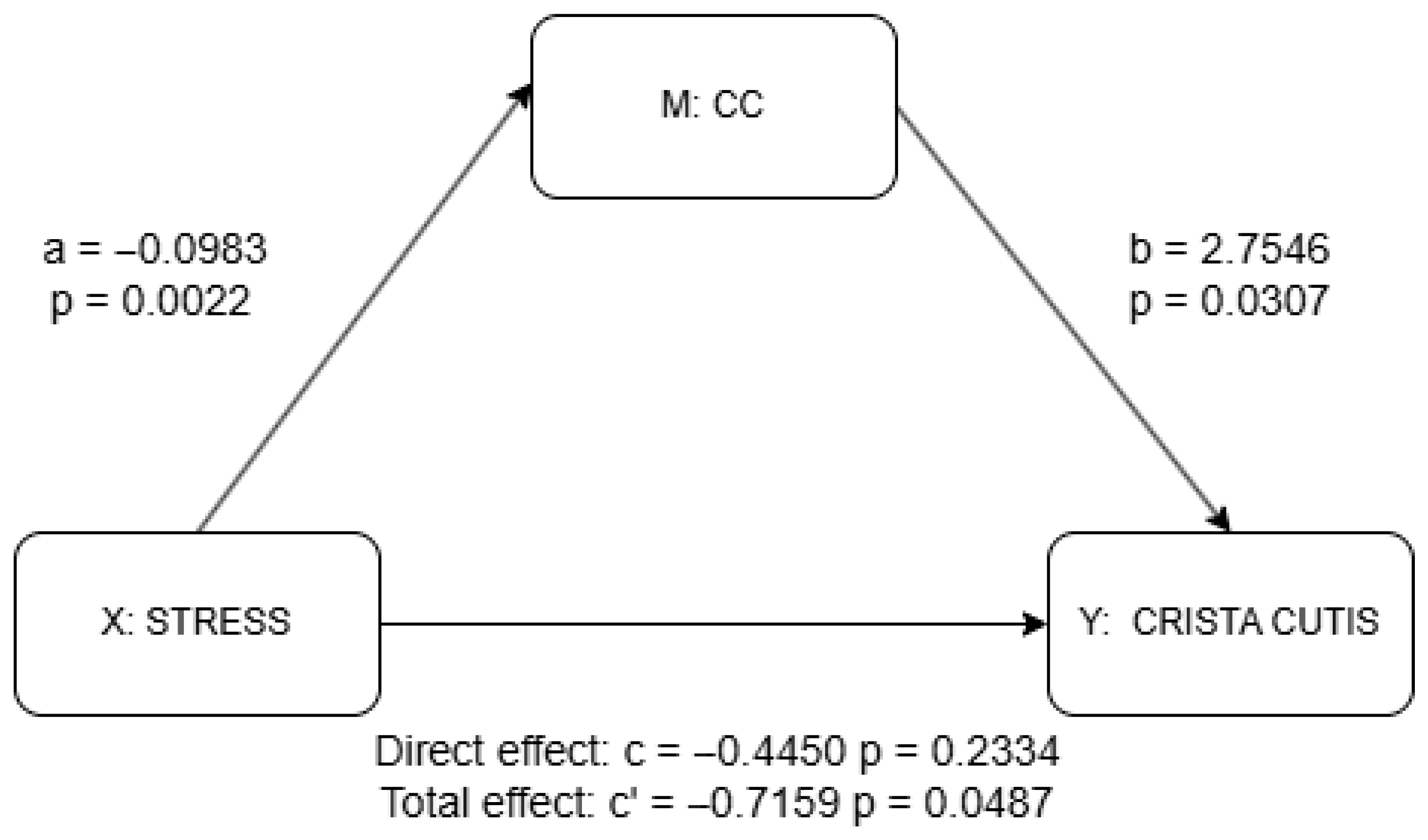White Matter Integrity of the Corpus Callosum Mediates the Association Between Aging and Skin Condition
Abstract
1. Introduction
2. Materials and Methods
2.1. Subjects
2.2. Skin Data
2.3. Demographic Scales
2.4. MRI Data Acquisition
2.5. FA-BHQ and GM-BHQ
2.6. Statistical Analysis
3. Results
4. Discussion
5. Limitation
6. Conclusions
Supplementary Materials
Author Contributions
Funding
Institutional Review Board Statement
Informed Consent Statement
Data Availability Statement
Acknowledgments
Conflicts of Interest
References
- Baumann, L. Skin ageing and its treatment. J. Pathol. 2007, 211, 241–251. [Google Scholar] [CrossRef]
- Dorland. Dorland’s Illustrated Medical Dictionary; Saunders: Philadelphia, PA, USA, 2015. [Google Scholar]
- Hiramoto, K.; Sugiyama, D.; Takahashi, Y.; Mafune, E. The amelioration effect of tranexamic acid in wrinkles induced by skin dryness. Biomed. Pharmacother. 2016, 80, 16–22. [Google Scholar] [CrossRef]
- Tobin, D.J. Introduction to skin aging. J. Tissue Viability 2017, 26, 37–46. [Google Scholar] [CrossRef]
- Chen, Y.; Lyga, J. Brain-skin connection: Stress, inflammation and skin aging: Ingenta connect. In Inflammation & Allergy-Drug Targets (Formerly Current Drug Targets—Inflammation & Allergy) (Discontinued); Bentham Science Publishers: Sharjah, United Arab Emirates, 2014; Available online: https://www.ingentaconnect.com/content/ben/iadt/2014/00000013/00000003/art00005 (accessed on 25 July 2025).
- Dunn, J.H.; Koo, J. Psychological stress and skin aging: A review of possible mechanisms and potential therapies. Dermatol. Online J. 2013, 19, 18561. [Google Scholar] [CrossRef] [PubMed]
- Elenkov, I.J.; Webster, E.L.; Torpy, D.J.; Chrousos, G.P. Stress, corticotropin-releasing hormone, glucocorticoids, and the immune/inflammatory response: Acute and chronic effects. Ann. N. Y. Acad. Sci. 1999, 876, 1–13. [Google Scholar] [CrossRef] [PubMed]
- Slominski, A.; Zbytek, B.; Pisarchik, A.; Slominski, R.; Zmijewski, M.; Wortsman, J. CRH functions as a growth factor/cytokine in the skin. J. Cell. Physiol. 2006, 206, 780–791. [Google Scholar] [CrossRef]
- Theoharides, T.C.; Singh, L.K.; Boucher, W.; Pang, X.; Letourneau, R.; Webster, E.; Chrousos, G. Corticotropin-releasing hormone induces skin mast cell degranulation and increased vascular permeability, a possible explanation for its proinflammatory effects. Endocrinology 1998, 139, 403–413. [Google Scholar] [CrossRef]
- Zbytek, B.; Mysliwski, A.; Slominski, A.; Wortsman, J.; Wei, E.T.; Mysliwska, J. Corticotropin-releasing hormone affects cytokine production in human HaCaT keratinocytes. Life Sci. 2002, 70, 1013–1021. [Google Scholar] [CrossRef] [PubMed]
- Park, H.J.; Kim, H.J.; Lee, J.Y.; Cho, B.K.; Gallo, R.L.; Cho, D.H. Adrenocorticotropin hormone stimulates interleukin-18 expression in human HaCaT keratinocytes. J. Investig. Dermatol. 2007, 127, 1210–1216. [Google Scholar] [CrossRef]
- Melanocortin-5 Receptor: A Marker of Human Sebocyte Differentiation—ScienceDirect. Available online: https://www-sciencedirect-com.kyoto-u.idm.oclc.org/science/article/pii/S0196978105004547 (accessed on 25 July 2025).
- Yoshida, K.; Nemoto, K.; Hamano, A.; Kawamori, M.; Arai, T.; Yamakawa, Y. Brain healthcare quotient as a tool for standardized approach in brain healthcare interventions. Life 2024, 14, 560. [Google Scholar] [CrossRef]
- Nemoto, K.; Oka, H.; Fukuda, H.; Yamakawa, Y. MRI-based Brain Healthcare Quotients: A bridge between neural and behavioral analyses for keeping the brain healthy. PLoS ONE 2017, 12, e0187137. [Google Scholar] [CrossRef]
- Kelly, S.; Jahanshad, N.; Zalesky, A.; Kochunov, P.; Agartz, I.; Alloza, C.; A Andreassen, O.; Arango, C.; Banaj, N.; Bouix, S.; et al. Widespread white matter microstructural differences in schizophrenia across 4322 individuals: Results from the ENIGMA schizophrenia DTI working group. Mol. Psychiatry 2018, 23, 1261–1269. [Google Scholar] [CrossRef] [PubMed]
- van Velzen, L.S.; Kelly, S.; Isaev, D.; Aleman, A.; Aftanas, L.I.; Bauer, J.; Baune, B.T.; Brak, I.V.; Carballedo, A.; Connolly, C.G.; et al. White matter disturbances in major depressive disorder: A coordinated analysis across 20 international cohorts in the ENIGMA MDD working group. Mol. Psychiatry 2020, 25, 1511–1525. [Google Scholar] [CrossRef] [PubMed]
- Dalgleish, T. The emotional brain. Nat. Rev. Neurosci. 2004, 5, 583–589. [Google Scholar] [CrossRef]
- Modi, S.; Trivedi, R.; Singh, K.; Kumar, P.; Rathore, R.K.; Tripathi, R.P.; Khushu, S. Individual differences in trait anxiety are associated with white matter tract integrity in fornix and uncinate fasciculus: Preliminary evidence from a DTI based tractography study. Behav. Brain Res. 2013, 238, 188–192. [Google Scholar] [CrossRef]
- Catani, M.; Howard, R.J.; Pajevic, S.; Jones, D.K. Virtual in vivo interactive dissection of white matter fasciculi in the human brain. Neuroimage 2002, 17, 77–94. [Google Scholar] [CrossRef]
- Lee, K.S.; Lee, S.H. White matter-based structural brain network of anxiety. In Anxiety Disorders: Rethinking and Understanding Recent Discoveries; Kim, Y.-K., Ed.; Springer: Singapore, 2020; pp. 61–70. [Google Scholar] [CrossRef]
- Keedwell, P.A.; Doidge, A.N.; Meyer, M.; Lawrence, N.; Lawrence, A.D.; Jones, D.K. Subgenual cingulum microstructure supports control of emotional conflict. Cereb. Cortex 2016, 26, 2850–2862. [Google Scholar] [CrossRef]
- Saar-Ashkenazy, R.; Guez, J.; Jacob, Y.; Veksler, R.; Cohen, J.E.; Shelef, I.; Friedman, A.; Benifla, M. White-matter correlates of anxiety: The contribution of the corpus-callosum to the study of anxiety and stress-related disorders. Int. J. Methods Psychiatr. Res. 2023, 32, e1955. [Google Scholar] [CrossRef]
- Saxena, K.; Tamm, L.; Walley, A.; Simmons, A.; Rollins, N.; Chia, J.; Soares, J.C.; Emslie, G.J.; Fan, X.; Huang, H. A preliminary investigation of corpus callosum and anterior commissure aberrations in aggressive youth with bipolar disorders. J. Child Adolesc. Psychopharmacol. 2012, 22, 112–119. [Google Scholar] [CrossRef]
- Mithani, K.; Davison, B.; Meng, Y.; Lipsman, N. The anterior limb of the internal capsule: Anatomy, function, and dysfunction. Behav. Brain Res. 2020, 387, 112588. [Google Scholar] [CrossRef] [PubMed]
- Feng, C.; Cui, Z.; Cheng, D.; Xu, R.; Gu, R. Individualized prediction of dispositional worry using white matter connectivity. Psychol. Med. 2019, 49, 1999–2008. [Google Scholar] [CrossRef]
- Karababa, I.F.; Bayazıt, H.; Kılıçaslan, N.; Celik, M.; Cece, H.; Karakas, E.; Selek, S. Microstructural changes of anterior corona radiata in bipolar depression. Psychiatry Investig. 2015, 12, 367. [Google Scholar] [CrossRef]
- Makris, N.; Kennedy, D.N.; McInerney, S.; Sorensen, A.G.; Wang, R.; Caviness, V.S.; Pandya, D.N. Segmentation of subcomponents within the superior longitudinal fascicle in humans: A quantitative, in vivo, DT-MRI study. Cereb. Cortex 2005, 15, 854–869. [Google Scholar] [CrossRef]
- Murphy, M.L.; Carballedo, A.; Fagan, A.J.; Morris, D.; Fahey, C.; Meaney, J.; Frodl, T. Neurotrophic tyrosine kinase polymorphism impacts white matter connections in patients with major depressive disorder. Biol. Psychiatry 2012, 72, 663–670. [Google Scholar] [CrossRef]
- Cohen, J. Statistical Power Analysis for the Behavioral Sciences; Routledge: London, UK, 2013. [Google Scholar]
- Skin Analysis | POLA Official: Anti-Aging Care, Whitening, and Cosmetics. Available online: https://www.pola.co.jp/skinanalysis/index.html (accessed on 25 July 2025).
- Kurosumi, M.; Mizukoshi, K.; Hongo, M.; Kamachi, M.G. The effect of observation angles on facial age perceptions: A case study of japanese women. PLoS ONE 2022, 17, e0279339. [Google Scholar] [CrossRef]
- Kurosumi, M.; Yabuzaki, J.; Kuribayashi, M.; Mizukoshi, K. Age-related changes in cheek skin movement: A case study of japanese women. Skin Res. Technol. 2024, 30, e13768. [Google Scholar] [CrossRef]
- Nitta, S.; Matsumoto, M.; Sugama, J.; Nakagami, G.; Okuwa, M.; Nakatani, T.; Sanada, H. New quantitative indicators of evaluating the skin care regimen for older adults with dry skin by using the digital image analysis. J. Nurs. Sci. Eng. 2016, 3, 93–100. [Google Scholar]
- Matsumoto, M.; Matsuo, J.; Dai, M.; Nishizawa, T.; Matsui, K.; Ichikawa, Y.; Okuwa, M.; Sugama, J.; Sanada, H. Influence of differences in washing methods on skin texture. Int. J. Cosmet. Sci. 2014, 36, 175–181. [Google Scholar] [CrossRef] [PubMed]
- Ichibori, R.; Fujiwara, T.; Tanigawa, T.; Kanazawa, S.; Shingaki, K.; Torii, K.; Tomita, K.; Yano, K.; Osaka Twin Research Group; Sakai, Y.; et al. Objective assessment of facial skin aging and the associated environmental factors in japanese monozygotic twins. J. Cosmet. Dermatol. 2014, 13, 158–163. [Google Scholar] [CrossRef] [PubMed]
- Mungmai, L.; Preedalikit, W.; Aunsri, N.; Amornlerdpison, D. Efficacy of cosmetic formulation containing perilla frutescens leaves extract for irritation and aging skin. Biomed. Pharmacol. J. 2020, 13, 779–787. [Google Scholar] [CrossRef]
- Konomi, M.; Suzuki, M.; Ogawa, T.; Otsuka, K.; Hagiwara, A.; Inagaki, T.; Itani, S.; Saito, Y. Examination of sleep disorders in patients with vertigo using the Japanese version of the Pittsburgh Sleep Quality Index (PSQI-J). Equilib. Res. 2014, 73, 502–511. [Google Scholar] [CrossRef]
- Doi, Y.; Minowa, M.; Uchiyama, M.; Okawa, M.; Kim, K.; Shibui, K.; Kamei, Y. Psychometric assessment of subjective sleep quality using the japanese version of the pittsburgh sleep quality index (PSQI-J) in psychiatric disordered and control subjects. Psychiatry Res. 2000, 97, 165–172. [Google Scholar] [CrossRef]
- Doi, Y. Development of the Japanese version of the Pittsburgh Sleep Quality Index (PSQI-J). Jpn. J. Psychiatr. Treat. 1998, 13, 755–763. [Google Scholar]
- Craig, C.L.; Marshall, A.L.; Sjöström, M.; Bauman, A.E.; Booth, M.L.; Ainsworth, B.E.; Pratt, M.; Ekelund, U.L.; Yngve, A.; Sallis, J.F.; et al. International physical activity questionnaire: 12-country reliability and validity. Med. Sci. Sports Exerc. 2003, 35, 1381–1395. [Google Scholar] [CrossRef] [PubMed]
- Murase, N.; Katsumura, T.; Ueda, C. International standardization of physical activity: Evaluation of the reliability and validity of the Japanese version of the International Physical Activity Questionnaire (IPAQ). J. Health Welf. Stat. 2002, 49, 1–9. [Google Scholar]
- IPAQ—Score. Available online: https://sites.google.com/view/ipaq/score (accessed on 25 July 2025).
- Heuchert, J.P.; McNair, D.M. Profile of Mood States 2nd EditionTM. 2012. Available online: https://psycnet.apa.org/doiLanding?doi=10.1037/t05057-000 (accessed on 25 July 2025).
- Konuma, H.; Hirose, H.; Yokoyama, K. Relationship of the Japanese translation of the profile of mood states second edition (POMS 2®) to the first edition (POMS®). Juntendo Med. J. 2015, 61, 517–519. [Google Scholar] [CrossRef]
- Heuchert, J.P.; McNair, D.M.; Yokoyama, K.; Watanabe, K. Profile of Mood States 2 (POMS 2) Japanese Version Manual; Kaneko Shobo: Tokyo, Japan, 2015. [Google Scholar]
- Sasaki, H.; Masutomi, H.; Nakamura, S.; Tanigawa, C.; Cui, Y.; Ishihara, K.; Yanagisawa, M.; Kokubo, T. Granola consumption with multiple prebiotics in japanese participants increases bifidobacterium abundance and improves stress and subjective sleepiness. Front. Nutr. 2025, 12, 1551313. [Google Scholar] [CrossRef] [PubMed]
- Nogimura, D.; Moriyasu, K.; Ishida, S.; Kohda, M.; Yazawa, T.; Morita, M. SNP associations in the L-citrulline metabolic pathway and vascular aging in the japanese population. PLoS ONE 2025, 20, e0323778. [Google Scholar] [CrossRef]
- Kullmann, S.; Schweizer, F.; Veit, R.; Fritsche, A.; Preissl, H. Compromised white matter integrity in obesity. Obes. Rev. 2015, 16, 273–281. [Google Scholar] [CrossRef]
- Daoust, J.; Schaffer, J.; Zeighami, Y.; Dagher, A.; García-García, I.; Michaud, A. White matter integrity differences in obesity: A meta-analysis of diffusion tensor imaging studies. Neurosci. Biobehav. Rev. 2021, 129, 133–141. [Google Scholar] [CrossRef]
- Corstjens, H.; Dicanio, D.; Muizzuddin, N.; Neven, A.; Sparacio, R.; Declercq, L.; Maes, D. Glycation associated skin autofluorescence and skin elasticity are related to chronological age and body mass index of healthy subjects. Exp. Gerontol. 2008, 43, 663–667. [Google Scholar] [CrossRef] [PubMed]
- Addor, F. Beyond photoaging: Additional factors involved in the process of skin aging. Clin. Cosmet. Investig. Dermatol. 2018, 11, 437–443. [Google Scholar] [CrossRef]
- Goodman, G.D.; Kaufman, J.; Day, D.; Weiss, R.; Kawata, A.K.; Garcia, J.K.; Santangelo, S.; Gallagher, C.J. Impact of smoking and alcohol use on facial aging in women: Results of a large multinational, multiracial, cross-sectional survey. J. Clin. Aesthetic Dermatol. 2019, 12, 28. [Google Scholar]
- Oyetakin-White, P.; Suggs, A.; Koo, B.; Matsui, M.S.; Yarosh, D.; Cooper, K.D.; Baron, E.D. Does poor sleep quality affect skin ageing? Clin. Exp. Dermatol. 2015, 40, 17–22. [Google Scholar] [CrossRef]
- Sundelin, T.; Lekander, M.; Kecklund, G.; Van Someren, E.J.W.; Olsson, A.; Axelsson, J. Cues of fatigue: Effects of sleep deprivation on facial appearance. Sleep 2013, 36, 1355–1360. [Google Scholar] [CrossRef]
- Spencer, R.L.; Hutchison, K.E. Alcohol, aging, and the stress response. Alcohol Res. Health 1999, 23, 272. [Google Scholar]
- Szatkowska, J.; Teofilak, M.; Śpiołek, O.; Siwiec, J.; Smyl, N.; Kędziora, F.; Wąsowicz, A.; Słowikowska, A.; Sztyler-Krąkowska, M.; Fabian, D. The role of physical activity in enhancing and preserving skin health. J. Educ. Health Sport 2024, 76, 56455. [Google Scholar] [CrossRef]
- Rittié, L.; Fisher, G.J. UV-light-induced signal cascades and skin aging. Ageing Res. Rev. 2002, 1, 705–720. [Google Scholar] [CrossRef]
- Gonzaga, E.R. Role of UV light in photodamage, skin aging, and skin cancer: Importance of photoprotection. Am. J. Clin. Dermatol. 2009, 10, 19–24. [Google Scholar] [CrossRef]
- Farage, M.A.; Miller, K.W.; Zouboulis, C.C.; Piérard, G.E.; Maibach, H.I. Gender differences in skin aging and the changing profile of the sex hormones with age. J. Steroids Horm. Sci. 2012, 3, 109. [Google Scholar] [CrossRef]
- Watanabe, K.; Kakeda, S.; Nemoto, K.; Onoda, K.; Yamaguchi, S.; Kobayashi, S.; Yamakawa, Y. Grey-matter brain healthcare quotient and cognitive function: A large cohort study of an MRI brain screening system in Japan. Cortex 2021, 145, 97–104. [Google Scholar] [CrossRef]
- Nemoto, K.; Kokubun, K.; Ogata, Y.; Koike, Y.; Arai, T.; Yamakawa, Y. Dark chocolate intake may reduce fatigue and mediate cognitive function and gray matter volume in healthy middle-aged adults. Behav. Neurol. 2022, 2022, 1–8. [Google Scholar] [CrossRef]
- Fujino, M.; Watanabe, K.; Yamakawa, Y. The personal trait of spiritual growth is correlated with the white matter integrity of the brain. Front. Hum. Neurosci. 2022, 16, 890160. [Google Scholar] [CrossRef] [PubMed]
- Kokubun, K.; Nemoto, K.; Yamakawa, Y. Brain conditions mediate the association between aging and happiness. Sci. Rep. 2022, 12, 4290. [Google Scholar] [CrossRef] [PubMed]
- Kokubun, K.; Ogata, Y.; Koike, Y.; Yamakawa, Y. Brain condition may mediate the association between training and work engagement. Sci. Rep. 2020, 10, 6848. [Google Scholar] [CrossRef] [PubMed]
- Pineda, J.C.D.; Kokubun, K.; Ikaga, T.; Yamakawa, Y. Housing quality and behavior affect brain health and anxiety in healthy japanese adults. Sci. Rep. 2021, 11, 11999. [Google Scholar] [CrossRef]
- Ni, Y.; Kokubun, K.; Nemoto, K.; Yamakawa, Y. Examination of the impact of curiosity and fatigue on brain condition. Sci. Rep. 2025, 15, 13005. [Google Scholar] [CrossRef]
- ITU-T H.861.1; Requirements on Establishing Brain Healthcare Quotients. Series H: Audiovisual and Multimedia Systems, E-Health Multimedia Services and Applications—Multimedia e-Health Data Exchange Services. International Telecommunication Union Telecommunication Standardization Bureau: Geneva, Switzerland, 2018. Available online: https://www.itu.int/rec/T-REC-H.861.1 (accessed on 30 September 2025).
- Smith, S.M.; Vale, W.W. The role of the hypothalamic-pituitary-adrenal axis in neuroendocrine responses to stress. Dialogues Clin. Neurosci. 2006, 8, 383–395. [Google Scholar] [CrossRef]
- Elewa, R.M.; Abdallah, M.; Youssef, N.; Zouboulis, C.C. Aging-related changes in cutaneous corticotropin-releasing hormone system reflect a defective neuroendocrine-stress response in aging. Rejuvenation Res. 2012, 15, 366–373. [Google Scholar] [CrossRef]
- Picó-Pérez, M.; Radua, J.; Steward, T.; Menchón, J.M.; Soriano-Mas, C. Emotion regulation in mood and anxiety disorders: A meta-analysis of fMRI cognitive reappraisal studies. Prog. Neuropsychopharmacol. Biol. Psychiatry 2017, 79, 96–104. [Google Scholar] [CrossRef]
- Howell, B.R.; McCormack, K.M.; Grand, A.P.; Sawyer, N.T.; Zhang, X.; Maestripieri, D.; Hu, X.; Sanchez, M.M. Brain white matter microstructure alterations in adolescent rhesus monkeys exposed to early life stress: Associations with high cortisol during infancy. Biol. Mood Anxiety Disord. 2013, 3, 21. [Google Scholar] [CrossRef]
- Rinne-Albers, M.A.W.; van der Werff, S.J.A.; van Hoof, M.-J.; van Lang, N.D.; Lamers-Winkelman, F.; Rombouts, S.A.; Vermeiren, R.R.J.M.; van der Wee, N.J.A. Abnormalities of white matter integrity in the corpus callosum of adolescents with PTSD after childhood sexual abuse: A DTI study. Eur. Child Adolesc. Psychiatry 2016, 25, 869–878. [Google Scholar] [CrossRef]
- Paul, R.H. The relationship between early life stress and microstructural integrity of the corpus callosum in a non-clinical population. Neuropsychiatr. Dis. Treat. 2008, 4, 193–201. [Google Scholar] [CrossRef][Green Version]
- Jackowski, A.P.; Douglas-Palumberi, H.; Jackowski, M.; Win, L.; Schultz, R.T.; Staib, L.W.; Krystal, J.H.; Kaufman, J. Corpus callosum in maltreated children with posttraumatic stress disorder: A diffusion tensor imaging study. Psychiatry Res. Neuroimaging 2008, 162, 256–261. [Google Scholar] [CrossRef] [PubMed]
- Teicher, M.H.; Andersen, S.L.; Polcari, A.; Anderson, C.M.; Navalta, C.P.; Kim, D.M. The neurobiological consequences of early stress and childhood maltreatment. Neurosci. Biobehav. Rev. 2003, 27, 33–44. [Google Scholar] [CrossRef]
- Villarreal, G.; Hamilton, D.A.; Graham, D.P.; Driscoll, I.; Qualls, C.; Petropoulos, H.; Brooks, W.M. Reduced area of the corpus callosum in posttraumatic stress disorder. Psychiatry Res. Neuroimaging 2004, 131, 227–235. [Google Scholar] [CrossRef] [PubMed]
- Matsuoka, K.; Yasuno, F.; Kishimoto, T.; Yamamoto, A.; Kiuchi, K.; Kosaka, J.; Nagatsuka, K.; Iida, H.; Kudo, T. Microstructural differences in the corpus callosum in patients with bipolar disorder and major depressive disorder. J. Clin. Psychiatry 2016, 77, 1915. [Google Scholar] [CrossRef]
- Rotarska-Jagiela, A.; Schönmeyer, R.; Oertel, V.; Haenschel, C.; Vogeley, K.; Linden, D.E. The corpus callosum in schizophrenia-volume and connectivity changes affect specific regions. Neuroimage 2008, 39, 1522–1532. [Google Scholar] [CrossRef]
- Galinowski, A.; Miranda, R.; Lemaitre, H.; Martinot, M.-L.P.; Artiges, E.; Vulser, H.; Goodman, R.; Penttilä, J.; Struve, M.; Barbot, A.; et al. Resilience and corpus callosum microstructure in adolescence. Psychol. Med. 2015, 45, 2285–2294. [Google Scholar] [CrossRef] [PubMed]





| Region 17. | Role | Example Associations |
|---|---|---|
| Fornix | Part of the limbic system; regulation of emotions by higher-order frontal cortical regions [17,18] | |
| Uncinate Fasciculus (UF) | Connects orbitofrontal cortex to temporal lobe; emotion regulation [18,19] | Heightened anxiety; major depressive disorder |
| Cingulum | Emotional processing [20,21] | Anxiety disorders; attentional bias toward negative interpersonal stimuli |
| Corpus Callosum (CC) | Critical interhemispheric commissure; integrates cognitive and emotional processing [22,23] | Anxiety and stress-related disorders; aggressive behavior in bipolar disorder |
| Internal Capsule (IC) | Convergence for thalamic radiations; emotional processing [24] | |
| Anterior Corona Radiata (ACR) | Connects thalamic and prefrontal regions; part of limbic-thalamo-cortical circuit; worry prediction and emotional control [25] | Bipolar I disorder |
| Superior Longitudinal Fasciculus (SLF) | Major association tract linking the parietal and frontal lobes; role in attention; executive function; and emotion regulation [27,28] | PTSD; OCD; depression |
| Coefficient | p-Value | ||
|---|---|---|---|
| Internal Capsule | 0.365 | 0.001 | ***‡ |
| Corpus Callosum | 0.316 | 0.004 | **‡ |
| Fornix | 0.189 | 0.088 | |
| Anterior Corona Radiata | 0.241 | 0.028 | * |
| Cingulum | 0.118 | 0.290 | |
| Superior Longitudinal Fasciculus | 0.153 | 0.167 | |
| Stress | −0.231 | 0.036 | * |
Disclaimer/Publisher’s Note: The statements, opinions and data contained in all publications are solely those of the individual author(s) and contributor(s) and not of MDPI and/or the editor(s). MDPI and/or the editor(s) disclaim responsibility for any injury to people or property resulting from any ideas, methods, instructions or products referred to in the content. |
© 2025 by the authors. Licensee MDPI, Basel, Switzerland. This article is an open access article distributed under the terms and conditions of the Creative Commons Attribution (CC BY) license (https://creativecommons.org/licenses/by/4.0/).
Share and Cite
Yuan, D.; Kokubun, K.; Nemoto, K.; Yamakawa, Y. White Matter Integrity of the Corpus Callosum Mediates the Association Between Aging and Skin Condition. Life 2025, 15, 1664. https://doi.org/10.3390/life15111664
Yuan D, Kokubun K, Nemoto K, Yamakawa Y. White Matter Integrity of the Corpus Callosum Mediates the Association Between Aging and Skin Condition. Life. 2025; 15(11):1664. https://doi.org/10.3390/life15111664
Chicago/Turabian StyleYuan, Daihaoyi, Keisuke Kokubun, Kiyotaka Nemoto, and Yoshinori Yamakawa. 2025. "White Matter Integrity of the Corpus Callosum Mediates the Association Between Aging and Skin Condition" Life 15, no. 11: 1664. https://doi.org/10.3390/life15111664
APA StyleYuan, D., Kokubun, K., Nemoto, K., & Yamakawa, Y. (2025). White Matter Integrity of the Corpus Callosum Mediates the Association Between Aging and Skin Condition. Life, 15(11), 1664. https://doi.org/10.3390/life15111664






